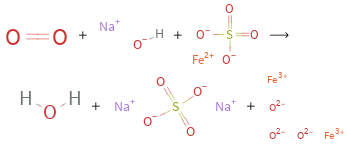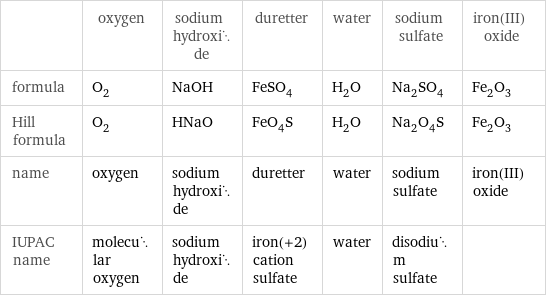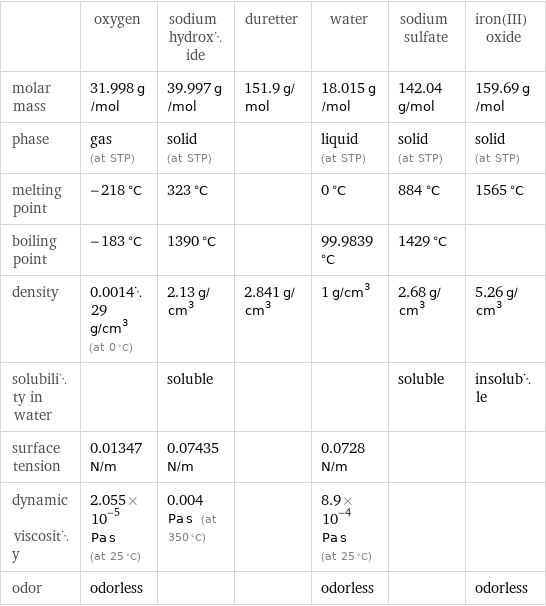Input interpretation

O_2 oxygen + NaOH sodium hydroxide + FeSO_4 duretter ⟶ H_2O water + Na_2SO_4 sodium sulfate + Fe_2O_3 iron(III) oxide
Balanced equation

Balance the chemical equation algebraically: O_2 + NaOH + FeSO_4 ⟶ H_2O + Na_2SO_4 + Fe_2O_3 Add stoichiometric coefficients, c_i, to the reactants and products: c_1 O_2 + c_2 NaOH + c_3 FeSO_4 ⟶ c_4 H_2O + c_5 Na_2SO_4 + c_6 Fe_2O_3 Set the number of atoms in the reactants equal to the number of atoms in the products for O, H, Na, Fe and S: O: | 2 c_1 + c_2 + 4 c_3 = c_4 + 4 c_5 + 3 c_6 H: | c_2 = 2 c_4 Na: | c_2 = 2 c_5 Fe: | c_3 = 2 c_6 S: | c_3 = c_5 Since the coefficients are relative quantities and underdetermined, choose a coefficient to set arbitrarily. To keep the coefficients small, the arbitrary value is ordinarily one. For instance, set c_1 = 1 and solve the system of equations for the remaining coefficients: c_1 = 1 c_2 = 8 c_3 = 4 c_4 = 4 c_5 = 4 c_6 = 2 Substitute the coefficients into the chemical reaction to obtain the balanced equation: Answer: | | O_2 + 8 NaOH + 4 FeSO_4 ⟶ 4 H_2O + 4 Na_2SO_4 + 2 Fe_2O_3
Structures

+ + ⟶ + +
Names

oxygen + sodium hydroxide + duretter ⟶ water + sodium sulfate + iron(III) oxide
Equilibrium constant
![Construct the equilibrium constant, K, expression for: O_2 + NaOH + FeSO_4 ⟶ H_2O + Na_2SO_4 + Fe_2O_3 Plan: • Balance the chemical equation. • Determine the stoichiometric numbers. • Assemble the activity expression for each chemical species. • Use the activity expressions to build the equilibrium constant expression. Write the balanced chemical equation: O_2 + 8 NaOH + 4 FeSO_4 ⟶ 4 H_2O + 4 Na_2SO_4 + 2 Fe_2O_3 Assign stoichiometric numbers, ν_i, using the stoichiometric coefficients, c_i, from the balanced chemical equation in the following manner: ν_i = -c_i for reactants and ν_i = c_i for products: chemical species | c_i | ν_i O_2 | 1 | -1 NaOH | 8 | -8 FeSO_4 | 4 | -4 H_2O | 4 | 4 Na_2SO_4 | 4 | 4 Fe_2O_3 | 2 | 2 Assemble the activity expressions accounting for the state of matter and ν_i: chemical species | c_i | ν_i | activity expression O_2 | 1 | -1 | ([O2])^(-1) NaOH | 8 | -8 | ([NaOH])^(-8) FeSO_4 | 4 | -4 | ([FeSO4])^(-4) H_2O | 4 | 4 | ([H2O])^4 Na_2SO_4 | 4 | 4 | ([Na2SO4])^4 Fe_2O_3 | 2 | 2 | ([Fe2O3])^2 The equilibrium constant symbol in the concentration basis is: K_c Mulitply the activity expressions to arrive at the K_c expression: Answer: | | K_c = ([O2])^(-1) ([NaOH])^(-8) ([FeSO4])^(-4) ([H2O])^4 ([Na2SO4])^4 ([Fe2O3])^2 = (([H2O])^4 ([Na2SO4])^4 ([Fe2O3])^2)/([O2] ([NaOH])^8 ([FeSO4])^4)](../image_source/4c592515248ea858a82871546494ad88.png)
Construct the equilibrium constant, K, expression for: O_2 + NaOH + FeSO_4 ⟶ H_2O + Na_2SO_4 + Fe_2O_3 Plan: • Balance the chemical equation. • Determine the stoichiometric numbers. • Assemble the activity expression for each chemical species. • Use the activity expressions to build the equilibrium constant expression. Write the balanced chemical equation: O_2 + 8 NaOH + 4 FeSO_4 ⟶ 4 H_2O + 4 Na_2SO_4 + 2 Fe_2O_3 Assign stoichiometric numbers, ν_i, using the stoichiometric coefficients, c_i, from the balanced chemical equation in the following manner: ν_i = -c_i for reactants and ν_i = c_i for products: chemical species | c_i | ν_i O_2 | 1 | -1 NaOH | 8 | -8 FeSO_4 | 4 | -4 H_2O | 4 | 4 Na_2SO_4 | 4 | 4 Fe_2O_3 | 2 | 2 Assemble the activity expressions accounting for the state of matter and ν_i: chemical species | c_i | ν_i | activity expression O_2 | 1 | -1 | ([O2])^(-1) NaOH | 8 | -8 | ([NaOH])^(-8) FeSO_4 | 4 | -4 | ([FeSO4])^(-4) H_2O | 4 | 4 | ([H2O])^4 Na_2SO_4 | 4 | 4 | ([Na2SO4])^4 Fe_2O_3 | 2 | 2 | ([Fe2O3])^2 The equilibrium constant symbol in the concentration basis is: K_c Mulitply the activity expressions to arrive at the K_c expression: Answer: | | K_c = ([O2])^(-1) ([NaOH])^(-8) ([FeSO4])^(-4) ([H2O])^4 ([Na2SO4])^4 ([Fe2O3])^2 = (([H2O])^4 ([Na2SO4])^4 ([Fe2O3])^2)/([O2] ([NaOH])^8 ([FeSO4])^4)
Rate of reaction
![Construct the rate of reaction expression for: O_2 + NaOH + FeSO_4 ⟶ H_2O + Na_2SO_4 + Fe_2O_3 Plan: • Balance the chemical equation. • Determine the stoichiometric numbers. • Assemble the rate term for each chemical species. • Write the rate of reaction expression. Write the balanced chemical equation: O_2 + 8 NaOH + 4 FeSO_4 ⟶ 4 H_2O + 4 Na_2SO_4 + 2 Fe_2O_3 Assign stoichiometric numbers, ν_i, using the stoichiometric coefficients, c_i, from the balanced chemical equation in the following manner: ν_i = -c_i for reactants and ν_i = c_i for products: chemical species | c_i | ν_i O_2 | 1 | -1 NaOH | 8 | -8 FeSO_4 | 4 | -4 H_2O | 4 | 4 Na_2SO_4 | 4 | 4 Fe_2O_3 | 2 | 2 The rate term for each chemical species, B_i, is 1/ν_i(Δ[B_i])/(Δt) where [B_i] is the amount concentration and t is time: chemical species | c_i | ν_i | rate term O_2 | 1 | -1 | -(Δ[O2])/(Δt) NaOH | 8 | -8 | -1/8 (Δ[NaOH])/(Δt) FeSO_4 | 4 | -4 | -1/4 (Δ[FeSO4])/(Δt) H_2O | 4 | 4 | 1/4 (Δ[H2O])/(Δt) Na_2SO_4 | 4 | 4 | 1/4 (Δ[Na2SO4])/(Δt) Fe_2O_3 | 2 | 2 | 1/2 (Δ[Fe2O3])/(Δt) (for infinitesimal rate of change, replace Δ with d) Set the rate terms equal to each other to arrive at the rate expression: Answer: | | rate = -(Δ[O2])/(Δt) = -1/8 (Δ[NaOH])/(Δt) = -1/4 (Δ[FeSO4])/(Δt) = 1/4 (Δ[H2O])/(Δt) = 1/4 (Δ[Na2SO4])/(Δt) = 1/2 (Δ[Fe2O3])/(Δt) (assuming constant volume and no accumulation of intermediates or side products)](../image_source/052636d857f0f0da841e4168f48d1c8e.png)
Construct the rate of reaction expression for: O_2 + NaOH + FeSO_4 ⟶ H_2O + Na_2SO_4 + Fe_2O_3 Plan: • Balance the chemical equation. • Determine the stoichiometric numbers. • Assemble the rate term for each chemical species. • Write the rate of reaction expression. Write the balanced chemical equation: O_2 + 8 NaOH + 4 FeSO_4 ⟶ 4 H_2O + 4 Na_2SO_4 + 2 Fe_2O_3 Assign stoichiometric numbers, ν_i, using the stoichiometric coefficients, c_i, from the balanced chemical equation in the following manner: ν_i = -c_i for reactants and ν_i = c_i for products: chemical species | c_i | ν_i O_2 | 1 | -1 NaOH | 8 | -8 FeSO_4 | 4 | -4 H_2O | 4 | 4 Na_2SO_4 | 4 | 4 Fe_2O_3 | 2 | 2 The rate term for each chemical species, B_i, is 1/ν_i(Δ[B_i])/(Δt) where [B_i] is the amount concentration and t is time: chemical species | c_i | ν_i | rate term O_2 | 1 | -1 | -(Δ[O2])/(Δt) NaOH | 8 | -8 | -1/8 (Δ[NaOH])/(Δt) FeSO_4 | 4 | -4 | -1/4 (Δ[FeSO4])/(Δt) H_2O | 4 | 4 | 1/4 (Δ[H2O])/(Δt) Na_2SO_4 | 4 | 4 | 1/4 (Δ[Na2SO4])/(Δt) Fe_2O_3 | 2 | 2 | 1/2 (Δ[Fe2O3])/(Δt) (for infinitesimal rate of change, replace Δ with d) Set the rate terms equal to each other to arrive at the rate expression: Answer: | | rate = -(Δ[O2])/(Δt) = -1/8 (Δ[NaOH])/(Δt) = -1/4 (Δ[FeSO4])/(Δt) = 1/4 (Δ[H2O])/(Δt) = 1/4 (Δ[Na2SO4])/(Δt) = 1/2 (Δ[Fe2O3])/(Δt) (assuming constant volume and no accumulation of intermediates or side products)
Chemical names and formulas

| oxygen | sodium hydroxide | duretter | water | sodium sulfate | iron(III) oxide formula | O_2 | NaOH | FeSO_4 | H_2O | Na_2SO_4 | Fe_2O_3 Hill formula | O_2 | HNaO | FeO_4S | H_2O | Na_2O_4S | Fe_2O_3 name | oxygen | sodium hydroxide | duretter | water | sodium sulfate | iron(III) oxide IUPAC name | molecular oxygen | sodium hydroxide | iron(+2) cation sulfate | water | disodium sulfate |
Substance properties

| oxygen | sodium hydroxide | duretter | water | sodium sulfate | iron(III) oxide molar mass | 31.998 g/mol | 39.997 g/mol | 151.9 g/mol | 18.015 g/mol | 142.04 g/mol | 159.69 g/mol phase | gas (at STP) | solid (at STP) | | liquid (at STP) | solid (at STP) | solid (at STP) melting point | -218 °C | 323 °C | | 0 °C | 884 °C | 1565 °C boiling point | -183 °C | 1390 °C | | 99.9839 °C | 1429 °C | density | 0.001429 g/cm^3 (at 0 °C) | 2.13 g/cm^3 | 2.841 g/cm^3 | 1 g/cm^3 | 2.68 g/cm^3 | 5.26 g/cm^3 solubility in water | | soluble | | | soluble | insoluble surface tension | 0.01347 N/m | 0.07435 N/m | | 0.0728 N/m | | dynamic viscosity | 2.055×10^-5 Pa s (at 25 °C) | 0.004 Pa s (at 350 °C) | | 8.9×10^-4 Pa s (at 25 °C) | | odor | odorless | | | odorless | | odorless
Units
